Friends of the Wildflower Garden
A web of present and past events

These short articles are written to highlight connections of the plants, history and lore of the Eloise Butler Wildflower Garden with different time frames or outside connections. A web of intersections.
Construction starts on new storage buildings. It's time to see the Jacob's Ladder and the wild roses and who is that well dressed man in the Garden pulling weeds?
This Month
Construction proceeds for storage buildings.
The well dressed man in the Garden
Construction proceeds for storage buildings.
Construction began in late April for two new tool and equipment sheds to be located just outside the current Garden fence near the rest rooms. These provide much needed space for the Garden’s equipment, most of which currently sits outside. It has been 110 years since the first storage building was erected in the Garden. It lasted for 65 years. The new buildings will be enclosed within the Garden fence when construction is completed. The contractor will make use of a small part of the parking lot, but the but more spaces for parking were added this spring. This project is part of the improvements recommended in the Theodore Wirth Park Master Plan and is funded by the Minneapolis Park & Recreation Board (MPRB).
Below: Ground work begins for the storage buildings at the Garden.
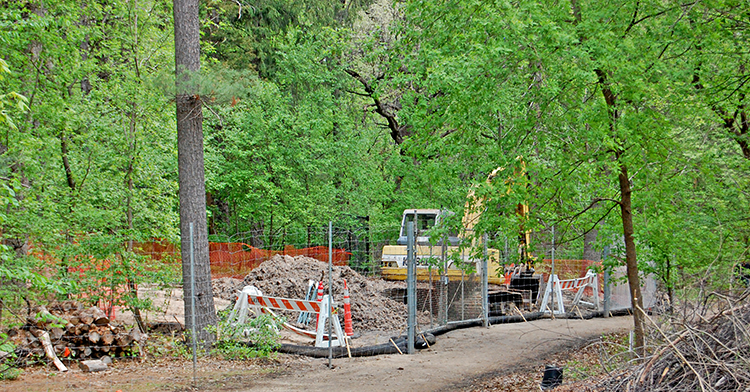

The two Jacob's Ladders
The blue flowers of spring have delicate hues, matching the soft colors of the early growing season. Jacob's Ladder (Polemonium reptans) is one such and we are fortunate to have it native in parts of the metro area, as it is not wide-spread in Minnesota. You will find it blooming in the woodland at the Wildflower Garden, as it has since 1910, in the last half of May and into early June.
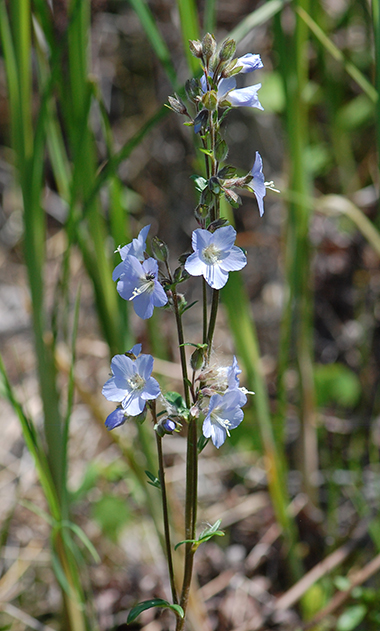
It has a reclusive relative that is found in only two counties in northern Minnesota - Western Jacob's Ladder (Polemonium occidentale spp. lacustre), so reclusive that its first finding in 1944 was widely disputed until the population of plants was re-discovered in 1988 near where it was originally reported.
The Polemonium genus covers a large number of plants world-wide commonly known as "Jacob's Ladder." Polemonium reptans, is more correctly named "Greek Valerian" but "Jacob's Ladder" will do.
Can you grow them?
The P. reptans species of Jacob's Ladder will grow quite nicely in the dappled shade of your garden if you have soils typical of the SE quarter of Minnesota. A bit of clay underneath doesn't bother it and rabbits and deer don't seem to browse it, plus, it transplants easily and will self seed.
Western Jacob's Ladder is a different story. It is rare, endangered, and occurs in the wild only in four locations in the coniferous forests of northern Minnesota and two in Wisconsin, making up the entire known population in North America. Those special growing conditions are hard to duplicate - but the Minnesota Landscape Arboretum has a native plant conservation program which has banked species of Western Jacob's Ladder from three of the known locations and has grown them at the Arboretum.
Reference our plant information sheets on Jacob's Ladder and Western Jacob's Ladder.
Below: Jacob's Ladder (Polemonium reptans) in the woodland at Eloise Butler.
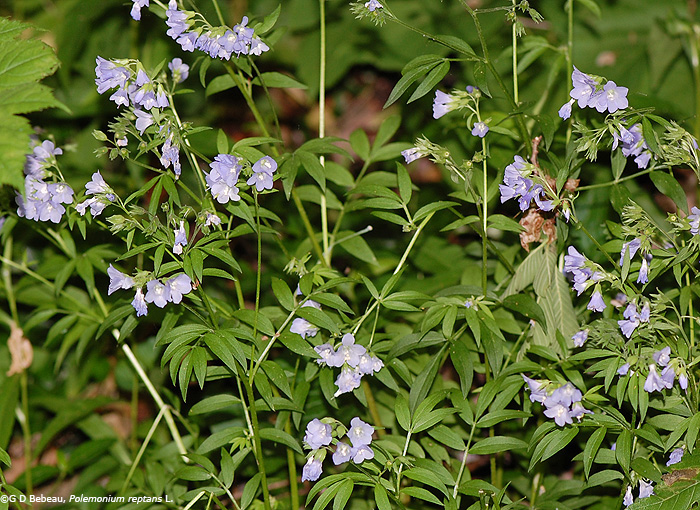

June is for wild roses
Eloise Butler asked - “How do the roses know that it is June? With the advent of the crowning month of the year, gardens, wild wood and prairie are ever redolent with the fragrance and glorified with the supernal loveliness of the rose.”
Elosie loved them. She planted ten species in her Native Plant Reserve. Take time during a June visit to the Wildflower Garden to look at and smell the ones that remain. Our Wild Rose Comparison page details six of the historical roses.
Most wild roses have a similar looking flower and aroma. Telling them apart requires some careful observation. Most are shrubby of course, but some form thickets and some just a nice clump and one forms arching climbing stems. Some spread rapidly, some not so. All have similar leaflets, but not similar leaves.
A word of caution for home gardeners. The Prairie Rose, Smooth Rose and Carolina Rose will spread by suckers widely, so plant it where you don't have to constantly cut our new suckers.
Eloise added this comment: "We may marvel at the skill of the florist in producing a cabbage-like double-dahlia and chrysanthemum; but we linger over and dearly love the single forms of these flowers. Banks of single roses in large gardens of double ones compel admiration and seem more decorative than the artificially produced double ones, to these possible-mistaken few."
Photo below: Prairie Wild Rose

The well dressed man in the Garden
On May 12,1949 the Minneapolis Tribune re-published an article from the Christian Science Monitor. It read: "The well-dressed man whom visitors to the Eloise Butler Wild Flower Garden in Minneapolis see pulling weeds every week-end except in the dead of winter is not the superintendent of parks."
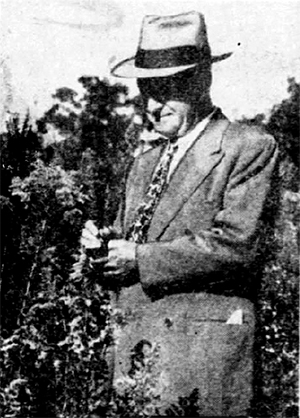
"Five days a week he is the chairman of the board of the saving cream company (Burma Shave) which adorns the roadside with jingles designed to discourage traffic accidents and encourage shavers to remove their whiskers with his products. While fellow businessmen are out digging holes in the turf on their favorite links, Clinton Odell is digging holes to plant some choice specimen just received from a distant part of the country."
This was publish 4 years after Odell had convinced the Board of Park Commissioners to add the upland area to the Eloise Butler Wildflower Garden and 3 years before he formed the Friends of the Wildflower Garden.
When he moved his Burma-Shave plant in 1940 to 2318 Chestnut Avenue West, it was just a short walk to the Garden and as he stated in a letter, he found his "interest in the Wild Flower Garden revived." He had noted in this personal journals his arguments with Eloise Butler about some of her plants and later had been in contact with the Park Commissioners about their benign neglect of the Garden and what should be done about it. At the time the Park System had fewer resources than it does today and a small area in the large expanses of Wirth Park was like a dot on a map.
And today? 75 years later the organization Odell founded is still pulling weeds. The Friends Greater Eloise Stewards have been active weeding and restoring habitat in the buffer area around the Garden (The Greater Eloise Volunteer Stewardship Area), spring and fall, for the past 17 years.
You can read more about Clinton Odell, his work for the Garden and why he founded the Friends of the Wildflower Garden in this article.
Historic Photo
Seventy-five years ago on June 23, 1949 Martha Crone made this Kodachrome of the Garden office with Prairie Sundrops blooming in front and Eloise Butler's pipe vines growing on the trellis. Prairie Sundrops will be blooming in the Upland Garden in June.
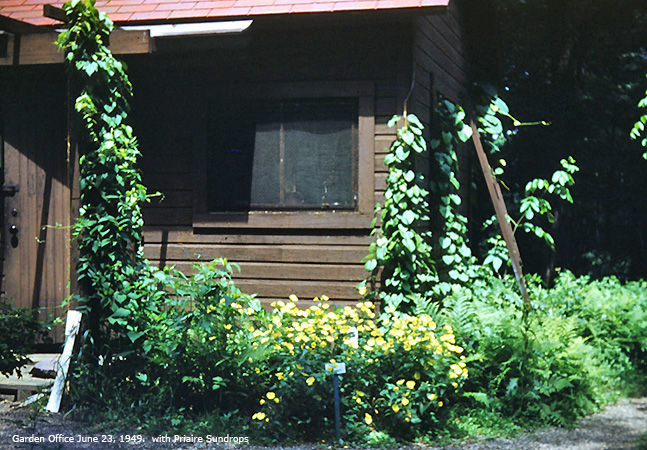
Previous articles
April 2024 - New construction at the Garden
April 2024 - An Eloise Butler Orchid
April 2024 - Water in the Wetland
March 2024 - Nostalgia: Snow in April
March 2024 - The life of a Redwing
March 2024 - Eloise plants - what?
March 2024 - The Norway Maple
February 2024 - Another decrease in winter monarchs
February 2024 - The last days of the Great Medicine Spring
February 2024 - Eloise Butler and early attempts to protect wildflowers
February 2024 - 1974 - the end of peaceful winters in South Wirth
February 2024 - Pussy Willow now showing signs of spring
All selections published in 2024
All selections published in 2023